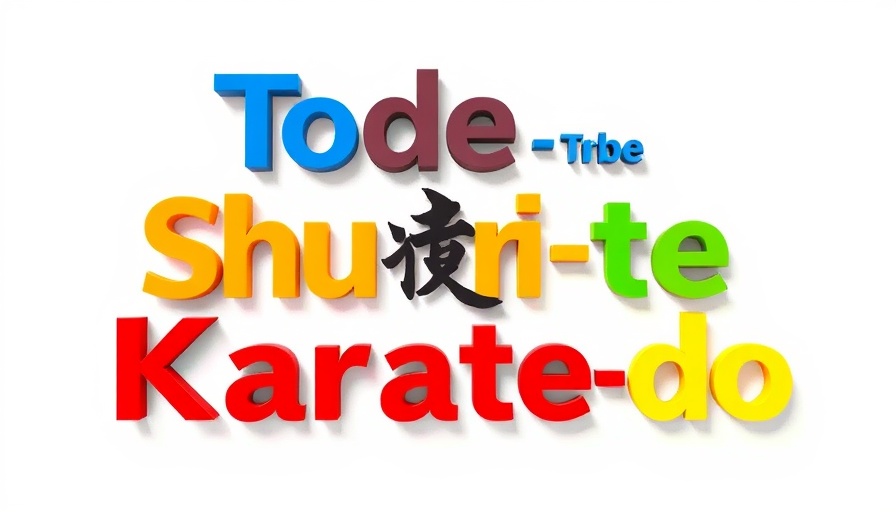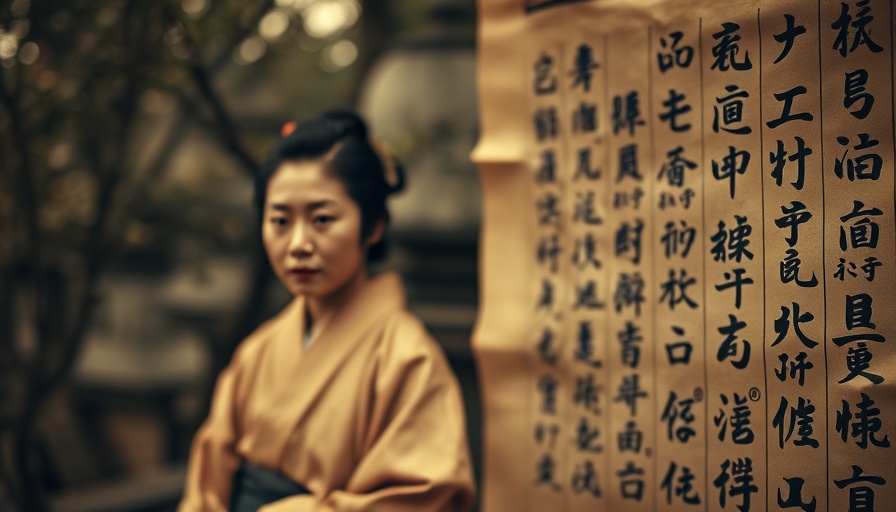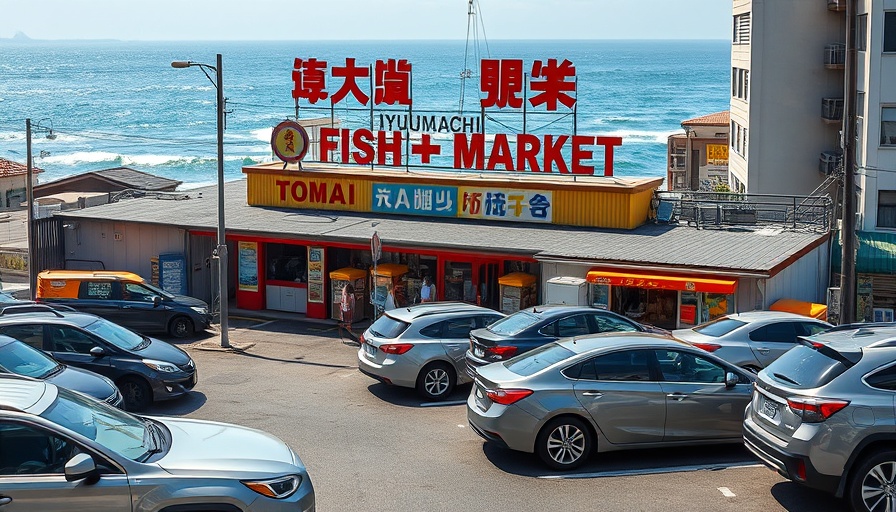Understanding the Wisdom of Two Legendary Fighters
Miyamoto Musashi, the greatest samurai of all time, and Bruce Lee, the iconic martial artist, both share timeless wisdom that transcends centuries. Despite being born 378 years apart, their philosophies on martial arts reflect a deep understanding of human behavior, strategy, and flexibility in both combat and life.
The Insight from Musashi's 'The Book of Five Rings'
Musashi’s seminal work, "The Book of Five Rings" (Go Rin No Sho), is as relevant today as it was during Japan's feudal era. In this text, Musashi explores various aspects of combat, strategy, and life through five elemental books. Of these, the Book of Water stands out for its focus on adaptability. Just like water, Musashi teaches that one must have the ability to flow in response to changing circumstances. This idea resonates profoundly in various aspects of modern life, from sports competition to corporate strategies.
Bruce Lee's Call to Be Like Water
Bruce Lee’s famous advice to “be like water” mirrors Musashi’s teachings on flexibility. Lee states, “Water can flow or it can crash.” This philosophy emphasizes the importance of adaptability in martial arts and life. By integrating Lee's approach alongside Musashi's concept of stickiness, we can understand the balance needed in combat—where staying attached to our opponent can yield greater effectiveness than trying to overpower them. Both masters encourage calmness and a strategic mindset during conflict.
Stickiness vs. Entanglement: Choosing the Right Approach
Both Lee and Musashi warn against falling into the trap of entanglement. In combat, the concept of stickiness means staying connected with your opponent while maintaining control, whereas entanglement leads to disadvantageous positions. Musashi describes this vividly, stating, “To apply stickiness… fix your longsword against the enemy as you receive his cut.” The difference lies in the firmness and purposefulness of our actions—akin to staying decisive in decision-making during chaotic situations.
The Battlefield: Avoiding the Mud of Entanglement
Musashi also warns about the perils of becoming bogged down in the “sticky mud” of warfare—excessive bureaucracy or conflict can lead to paralysis in action. In martial arts, this can be likened to a stalemate in competitive scenarios, where athletes become entangled due to indecision or overthinking. For instance, a critiqued wrestling match can lead to a pause in action that favors neither competitor. The success lies in the ability to break free and reset, reflecting the importance of adaptability in any competitive environment.
Rodeo Wisdom and Modern Applications
A rodeo bareback rider once remarked, “Hold on tight, and stay loose.” This advice captures the essence of both Musashi's and Lee's philosophies: maintain a firm grip on your goals and objectives while remaining flexible and open to change. This balance is crucial not only in martial arts but also in daily life, encouraging students and practitioners alike to apply mindfulness and adaptability in their pursuits.
The Journey: Using Lessons in Daily Life
While Musashi and Lee left behind them legacies rich in martial wisdom, their insights extend beyond the dojo. They challenge us to cultivate a calm mind—perhaps the true essence of martial arts. A focus on flexibility, stickiness in our engagements, and a careful avoidance of entanglement can profoundly affect personal interactions and challenge how we deal with unexpected circumstances. Leaders, teachers, and students of all ages can benefit by embracing this dual philosophy.
Key Takeaways from Musashi and Bruce Lee
- Water symbolizes flexibility and adaptability.
- Stickiness in battle engages effectively with the opponent.
- Entanglement proves unproductive.
- A calm mind fosters better decision-making.
- Consistency in practice leads to mastery in martial arts and life.
By applying the wisdom of Miyamoto Musashi and Bruce Lee, individuals can better navigate through conflicts and challenges, both in martial arts and in various aspects of life. Their teachings remind us that the true path of martial arts and personal growth lies in balance, adaptability, and mindfulness.
Call to Action
If you are captivated by the profound insights of Musashi and Lee, consider joining our martial arts classes. There, you can learn not just the techniques but also the philosophical foundations that empower both self-defense and personal development. Embrace the wisdom of great masters today!
04.20.2025
Exploring the Evolution of Karate’s Terminology and Its Impact
Update Understanding Karate's Evolving Terminology
Karate isn't just a martial art; it's a vibrant story that captures the essence of Okinawa's culture, intertwining strength, wisdom, and resilience throughout its long history. Each name and term associated with Karate reflects its evolution and adaptation over the centuries as it absorbed various cultural influences. The Historical Roots: Ti, Tōde, and Tuudii
The earliest terminology used to describe Karate includes "Ti" (手), "Tōde" (唐手), and "Tuudii" (literally meaning China hand). These terms date back to a time when Okinawa had strong cultural ties with China, predating the 18th century. They symbolize a historic bridge between the martial practices of two regions. This exchange carved out a path for Karate as we know it, fostering a rich blend of knowledge and techniques that would resonate through time. Regional Styles: The Birth of Tomari, Shuri, and Naha
As the 20th century rolled in, distinct styles of Okinawan martial arts began to emerge—specifically "Tomari-te," "Shuri-te," and "Naha-te." Each of these styles represents its geographic roots, embodying unique practices and philosophies influenced by traditions within the villages of Tomari, Shuri, and Naha. Furthermore, renowned figures such as Sokon Matsumura and Kanryo Higaonna were vital in developing these localized branches. Their teachings not only enriched the martial arts community but also emphasized the essential link between culture and practice. The Evolution of Terminology: An Uncertain Timeline
Modern records show that the terms "Shuri-te," "Naha-te," and "Tomari-te" were first officially noted in 1927. This was marked by a demonstration organized for the visit of Kōdōkan’s chairman, highlighting the burgeoning recognition of these styles. Notably, the mention of "Tomari-te" dates back even further to 1913, indicating its defined presence within Karate vocabulary. However, definitive historical evidence of these terms in regards to distinct styles before 1900 is murky, showing that much of Karate's transmission was informal and oral during that era. Lessons for Modern Martial Artists
Understanding the evolution of Karate's terminology offers significant insights for today's practitioners. Appreciating the rich tapestry of influences can deepen your training and connection to the art. By embracing both traditional forms and their cultural roots, martial artists can cultivate a more profound understanding of their training, promoting a holistic approach to self-defense and personal development. Why Karate Matters Today
In an age where self-defense skills are increasingly relevant, grasping Karate's history and terms can enhance one's training in practical ways. Knowing the origins of techniques and the philosophies behind them enriches the learning experience and instills greater confidence in their application, whether in the dojo or everyday situations. Unlock Your Potential with Karate
Curious to take your martial arts journey further? Delve deeper by joining a local dojo—like Gruber's Karate in Gurnee, where expert training brings out the best in every student. Build not just strength and discipline, but also a confident mindset that empowers you both physically and mentally.
04.20.2025
Master Effective Karate Training While Preserving Your Health
Update Unraveling Anko Itosu’s Timeless WisdomIn martial arts, Anko Itosu’s teachings have stood the test of time, particularly his ‘Ten Precepts of Karate’ which emphasize both skill and health in training. Among these, the ninth precept serves as a particularly insightful reminder of balance in practice. Itosu states, “When practicing Karate, do not put too much force or stress on your body; control your resources of strength.” This phrase not only reflects a deep understanding of effective martial arts practice but also underlines the imperative of health in training.The Danger of Overexertion in KarateItosu’s warning against excessive force is especially relevant today. He notes, “If not, your face and eyes will turn red.” This physical manifestation of strain is a caution that echoes through the decades, reinforcing the link between one's physical condition and training intensity.Health First: The Principles Behind KarateThe importance of health in martial arts goes beyond just physical well-being; it speaks to the psychological and emotional state of the practitioner. Itosu emphasizes that overexertion could lead not just to fatigue but to serious health risks, making moderation essential. His advice precedes modern sports science, which advocates avoiding burnout and injuries through careful training.Fuelling Personal Development Through Controlled PracticeUnderstanding the essence of Itosu’s precept is crucial for any adult aspiring to master karate, particularly within Gurnee's traditional martial arts sphere. Ensuring that practice doesn't lead to injury opens doors to more effective real-world self-defense and personal growth. Karate is not just a physical discipline; it is a mental training ground that fosters confidence, focus, and resilience.Building a Sustainable Karate PracticeThis ideal of balance enables practitioners to stay motivated and engaged. By implementing structured practices like applied Shotokan training, karate students can learn to appreciate the subtleties of their movements without the risk of overexertion. In Gurnee, karate classes can focus on these aspects to ensure that every stroke not only builds strength but also enhances overall health.Conclusion: Enroll for a Healthier FutureKarate is a lifelong journey that mirrors the growth and discipline found in effective self-defense techniques. Anko Itosu’s teachings remind us that health should never be compromised in pursuit of skill. Join us at Gruber’s Karate to build confidence, discipline, and strength through a balanced approach. Enroll Now at Gurnee's trusted 5 Star Martial Arts Center!
04.20.2025
Why Tomari Iyumachi Fish Market is a Must-Visit for Seafood Lovers
Update Discovering Okinawa's Gem: The Tomari Iyumachi Fish Market
Naha City is home to a hidden jewel in Okinawa—a vibrant fish market known as the Tomari Iyumachi Fish Market. Since its inception in May 2005, this bustling marketplace has become a cornerstone for local seafood lovers and a showcase of Okinawa's unique marine offerings. The name ‘Iyumachi’ translates to ‘fish market’ in the Okinawan dialect, with ‘iyu’ meaning 'fish' and ‘machi’ meaning 'market'. Where Freshness Meets Tradition
Positioned within the Tomari Fishing Port, the market features approximately 20 to 24 wholesale shops brimming with colorful seafood varieties, many of which are exclusive to Okinawa. With an average daily catch of about 20 tons—rising to as much as 50 tons during peak seasons—Tomari Iyumachi is a seafood paradise. Tuna, making up about 70% of the catch, reigns supreme here. Some market vendors even offer nationwide shipping, granting seafood lovers across Japan access to these fresh treasures. A Feast for the Senses
Not only does Tomari Iyumachi serve as a shopping destination, but it also invites visitors to relish Okinawa's culinary culture onsite. From sashimi and sushi to tempura and savory seafood rice bowls, the market provides numerous ready-to-eat options for guests. Dining while soaking up the lively atmosphere, surrounded by the chatter of vendors, fills the experience with familiarity and warmth—qualities that define Okinawa’s spirit. Experience the Action at the Dismantling Room
A unique feature of the market is the glass-walled dismantling room, where visitors can witness the fascinating process of how fish, particularly tuna, is processed. Timing is crucial, as the spectacle occurs during specific hours throughout the day—making it a thrilling opportunity for both locals and tourists. Shop Early for the Best Catch
For those planning to visit, early morning is the best time to explore. Shops typically sell out of their freshest seafood before noon, prompting some vendors to close their stalls. Therefore, an early start not only ensures a wider selection but also provides the true market experience before the vibrancy begins to fade. Connect with Local Culture
Tomari Iyumachi is more than just a fish market; it's a cultural hub. This place encapsulates the essence of Okinawa, welcoming visitors to immerse themselves in local customs and flavors. The market is a vital component of Okinawa’s social framework and an excellent example of the traditional practices that continue to thrive in modern times. This unique blend of tradition and culinary excellence makes it an essential stop for anyone exploring the area.
By participating in this vibrant community, visitors have the opportunity to not only enjoy delicious seafood but also acquire insights into the lifestyle and traditions of the Okinawan people.
So, whether you’re a local or a traveler, make sure to venture to the Tomari Iyumachi Fish Market. It’s not just about the fresh seafood; it’s about savoring the local culture and traditions that breathe life into this extraordinary destination.
Ready to strengthen your own personal development and discipline through martial arts? Build Confidence, Discipline, & Strength. Enroll Now At Gruber’s Karate, Gurnee’s Trusted 5 Star Martial Arts Center! Sensei@gruberskarate.com Gruber's Karate 5725 Stearns School Rd Gurnee, IL 60031 (224) 347-6655 GrubersKarate.com

 Add Row
Add Row  Add
Add 








Write A Comment